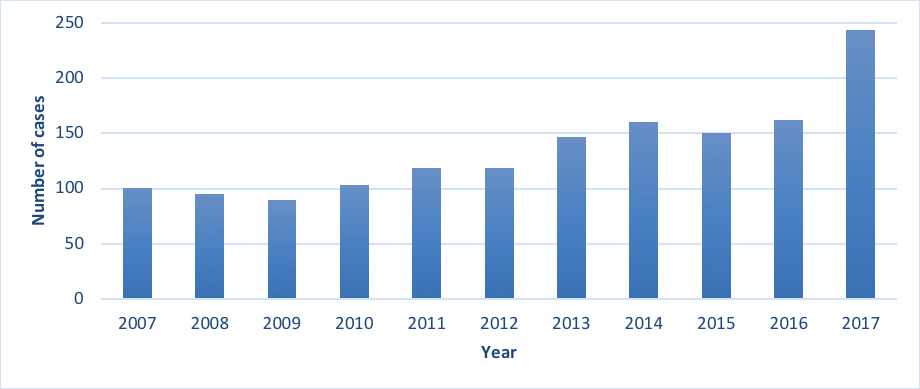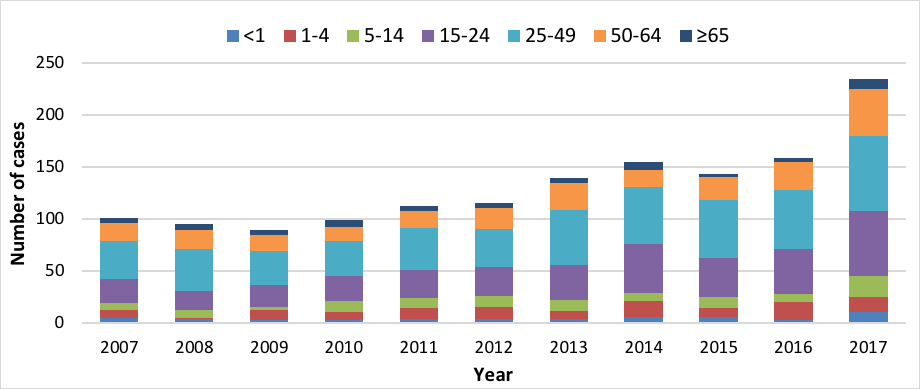09 Jan 2018
Increase in invasive group A Streptococcus disease in Victoria in 2017
Streptococcus pyogenes (group A Streptococcus, or GAS) is a gram-positive bacterial pathogen, which whilst primarily causing non-invasive infections such as pharyngitis, is also responsible for a diverse array of invasive human infections that cause substantial morbidity and mortality, including necrotising fasciitis, osteomyelitis, and streptococcal toxic shock syndrome [1]. Additionally, GAS is associated with several serious non-suppurative sequelae, including Acute Rheumatic Fever (ARF) and Rheumatic Heart Disease (RHD) [2].
Whilst GAS is not currently a notifiable infection in Victoria, the Victorian Chief Health Officer issued a health advisory regarding an increase in cases of invasive Group A streptococcal (iGAS) disease seen in children at Victoria’s Royal Children’s Hospital in early November 2017 [3]. To investigate this increase, a 10 year review of the number of iGAS isolations in Victoria was conducted at the Microbiological Diagnostic Unit Public Health Laboratory (MDU), through analysis of notifications to the Victorian Hospital Pathogen Surveillance System (VHPSS) and isolates sent to MDU for routine identification and typing.
The VHPSS is a voluntary surveillance system run by MDU that receives notifications of bacterial and fungal bloodstream and cerebrospinal fluid infections as reported by participating laboratories across the state. Health services and diagnostic laboratories also send isolates from suspected iGAS infections to MDU for identification and emm typing. Based on the number of cases captured by MDU through the VHPSS and routine testing, iGAS infections in Victoria appear to be on the rise.
Whilst the number of iGAS cases in the 9 years preceding 2017 appears to have risen steadily, 2017 saw a substantial jump in cases (Figure 1), with a 48% increase in the number of iGAS cases notified to the VHPSS between 2016 and 2017. A total of 235 iGAS cases were notified to VHPSS or sent to MDU for typing in 2017, exceeding the annual total for any year in the past decade. There was also an increase in the number of cases observed in the <1 and 5-14 year age groups (Figure 2), matching the surge in cases seen at the Royal Children’s Hospital that initially prompted the Health advisory.

Figure 1. Number of Victorian invasive group A Streptococcus cases referred to MDU, 2007-217

Figure 2. Victorian invasive group A Streptococcus infections by age group, 2007-2017
This trend has also been observed in Queensland, the only Australian state where iGAS is notifiable. Queensland saw a 32% increase in iGAS cases between 2016 and 2017, representing the highest number of cases in the past 5 years [4].
As iGAS infection is not currently notifiable in Victoria, MDU referrals and VHPSS notifications represent some of the most comprehensive sources of iGAS data in Victoria. However, the voluntary nature of these data sources likely results in an underrepresentation of the true number of iGAS infections occurring across the state.
Without consistent and comprehensive collection of data on iGAS infections in Victoria and nationally, it is difficult to establish whether the sudden increase in cases observed in 2017 represents a true increase in cases, and whether this increase is occurring across Australia or is isolated to Victoria and Queensland. Comprehensive surveillance of iGAS infections is required to establish whether this increase is indicative of a local and/or national increase in iGAS infections, and to inform the most effective public health response.
Author: Mathilda Wilmot (MDU)
The VHPSS is funded by the Victorian Government Department of Health and Human Services


